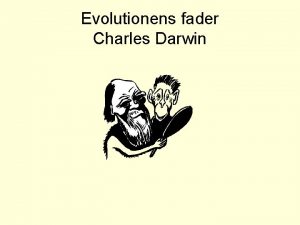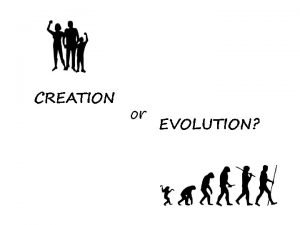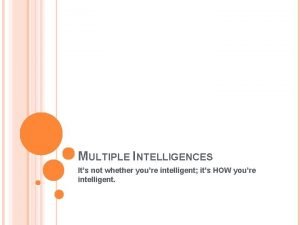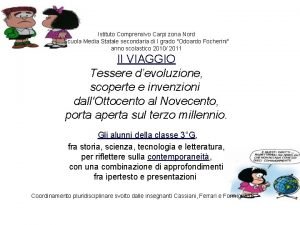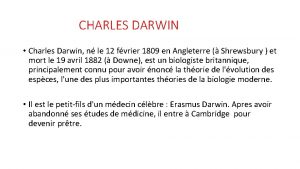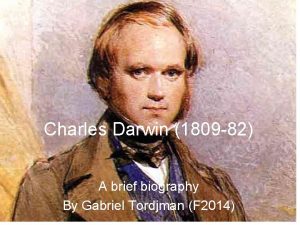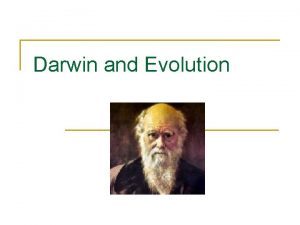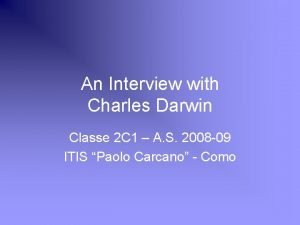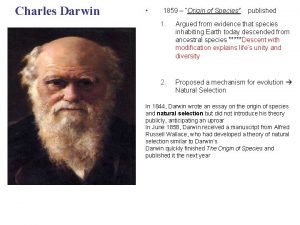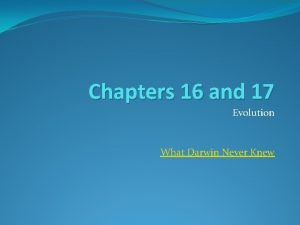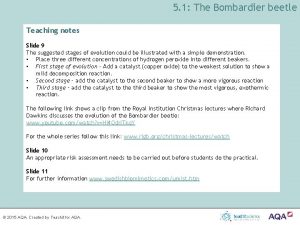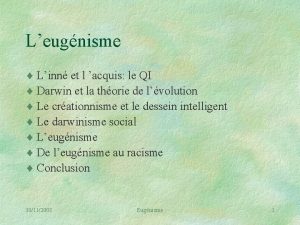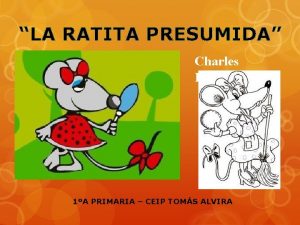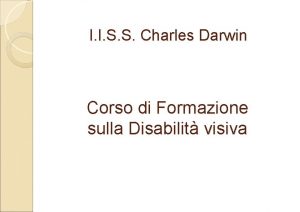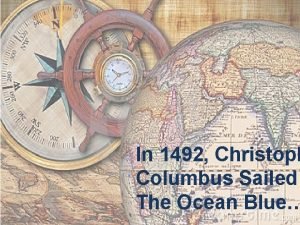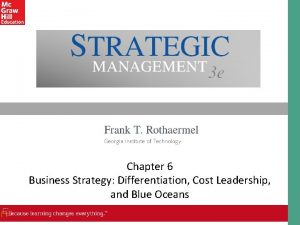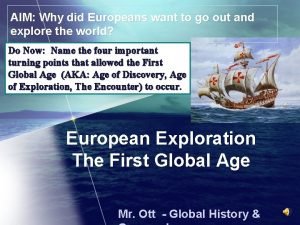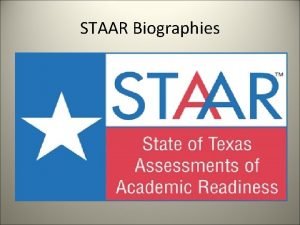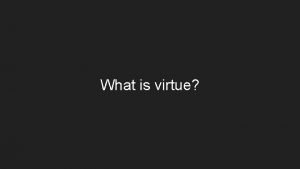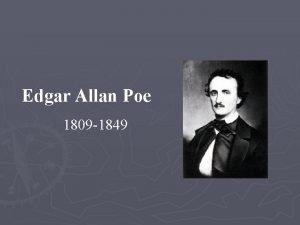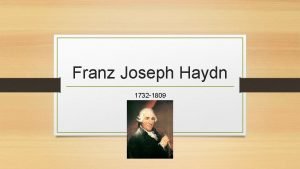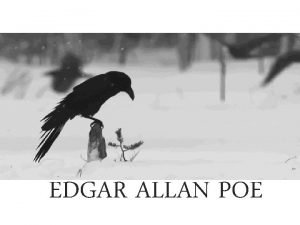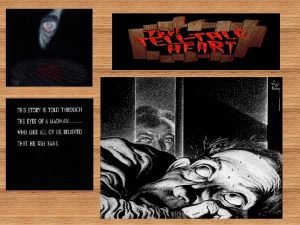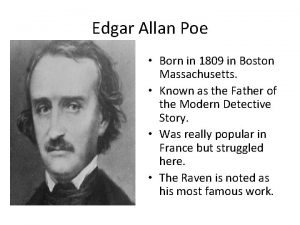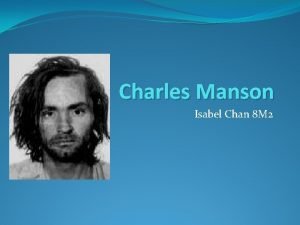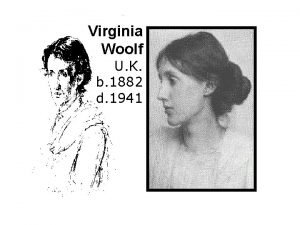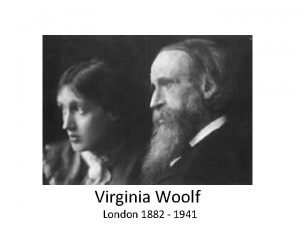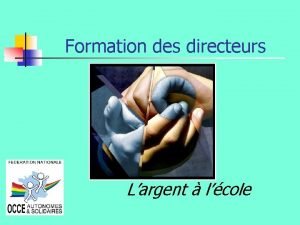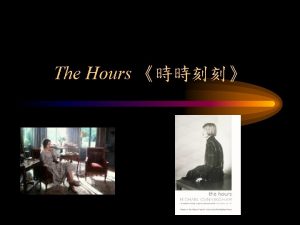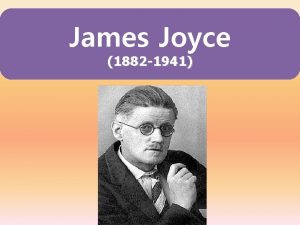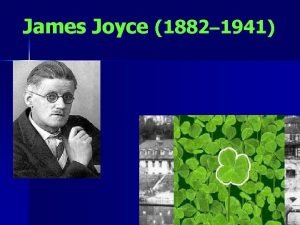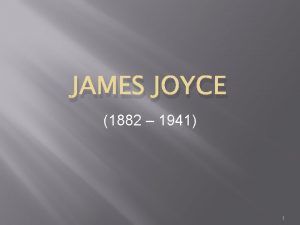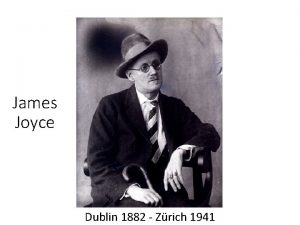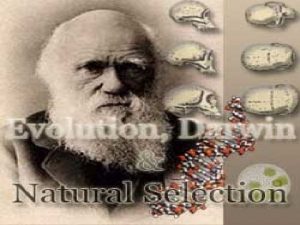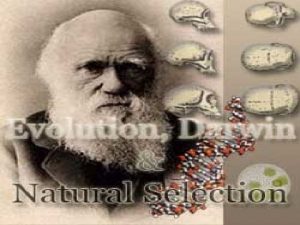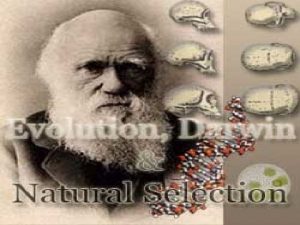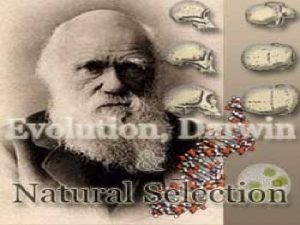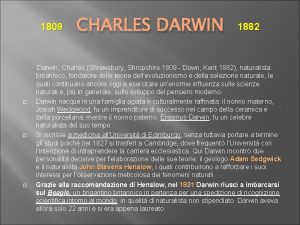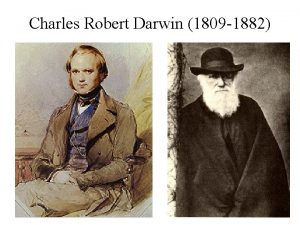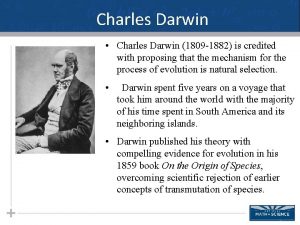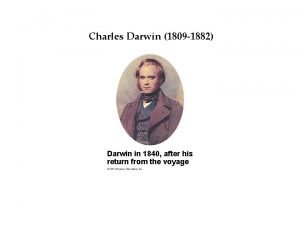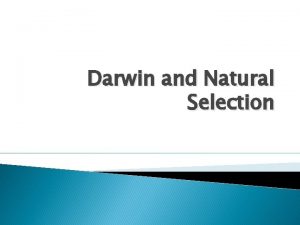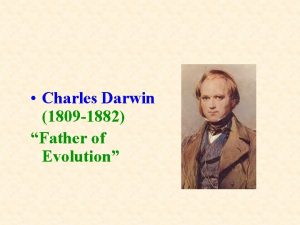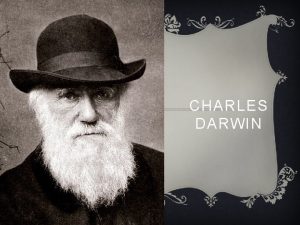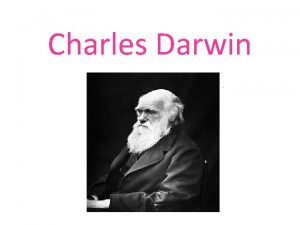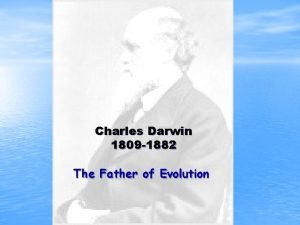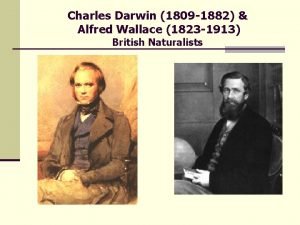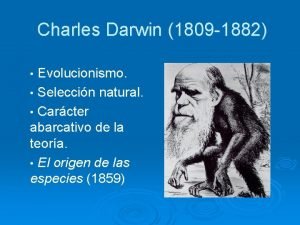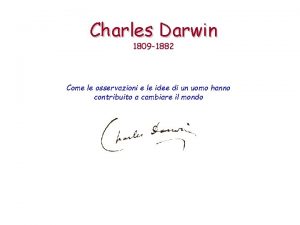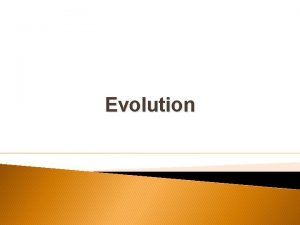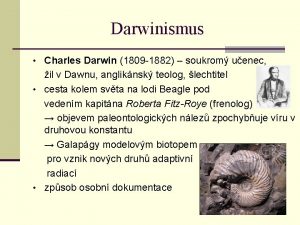Charles Darwin 1809 1882 Sailed around the world















































- Slides: 47


Charles Darwin (1809 -1882) Sailed around the world 1831 -1836

What did Darwin’s Travels reveal § The diversity of living species was far greater than anyone had previously known!! § These observations led him to develop theory of evolution!!

How did tortoises and birds differ among the islands of the Galapagos? § Each island had its own type of tortoises and birds that were clearly different from other islands

Phylogeny of the Galapagos Finches

Galapagos Turtles

Evolution is when organisms change over time. So, modern organisms descended from ancient ones

Evolution is a Theory – Just like Gravity! • Evolution is a well supported explanation of phenomena that have occurred in the natural world • A theory in science is a well tested hypothesis, not just a guess

Geologists: Hutton and Lyell Fundamentalists said that the earth was around 6000 years old Hutton and Lyell argued that the earth is many millions of years old b/c § layers of rock take time to form § processes such as volcanoes and earthquakes shaped the earth and still occur today

Lamarck Theory of acquired characteristics § Lamark said organisms acquired traits by using their bodies in new ways § These new characteristics were passed to offspring § Lamark was totally wrong!

Malthus § Reasoned that if the human population continued to grow unchecked, sooner or later there would be insufficient living space and food for everyone

Darwin finally published his ideas in 1859 § Other naturalists were developing the same theory that Darwin did. § Even though he was afraid of the Church’s reaction to his book he wanted to get credit for his work.

Macroevolution § The origin of taxonomic groups higher than the species level.

Microevolution § A change in a population’s gene pool over a secession of generations. § Evolutionary changes in species over relatively brief periods of geological time.

Five Mechanisms of Microevolution 1. Genetic drift: Change in the gene pool of a small population due to chance. § Two examples: a. Bottleneck effect b. Founder effect

a. Bottleneck Effect § Genetic drift (reduction of alleles in a population) resulting from a disaster that drastically reduces population size. § Examples: 1. Earthquakes 2. Volcanoes 3. Disease


b. Founder Effect § Genetic drift resulting from the colonization of a new location by a small number of individuals. § Results in random change of the gene pool. § Example: 1. Islands (first Darwin finch)


Five Mechanisms of Microevolution 2. Gene Flow: The gain or loss of alleles from a population by the movement of individuals or gametes. § Immigration or emigration.

Five Mechanisms of Microevolution 3. Mutation: Change in an organism’s DNA that creates a new allele. 4. Non-random mating: The selection of mates other than by chance. 5. Natural selection: Differential reproduction.

Artificial Selection § nature provides variation, humans select variations that are useful. § Example - a farmer breeds only his best livestock

Natural Selection § The traits that help an organism survive in a particular environment are “selected” in natural selection




Natural Selection and Species Fitness § Over time, natural selection results in changes in the inherited characteristics of a population. § These changes increase a species fitness (survival rate)


Different kinds of selection § Disruptive selection § Extremes are selected for § Might be where the two sexes come from § Trait was probably gamete sized § Two ‘mating types’

Different kinds of selection § Stabilizing or Normalizing selection § The middle is selected for § Many examples here § Symmetry § Two eyes

Different types of selection § Directional Selection § What most of us think about when we think about selection § An extreme value is selected for § Human brain size is a nice example

Summary of Darwin’s Theory 1. Organisms differ; variation is inherited 2. Organisms produce more offspring than survive 3. Organisms compete for resources 4. Organisms with advantages survive to pass those advantages to their children 5. Species alive today are descended with modifications from common ancestors

Evidence of Evolution 1. Fossil Record 2. Geographic Distribution of Living Species 3. Homologous Body structures 4. Similarities in Embryology

Evidence of Evolution Fossil Record provides evidence that living things have evolved Fossils show the history of life on earth and how different groups of organisms have changed over time

Primate Fossils Australopithecus Homo erectus Homo sapien

Primate Brain Capacity

Primate Bone structure

Australopithecus afarensis

Homo habilis = handy human 1. 5 to 2 mya Homo erectus 1. 6 mya bipedal

Modern Homo sapien (fully modern fossils 100, 000 ya)

Evidence of Evolution 2. Geographic Distribution of Living Species Similar animals in different locations were the product of different lines of descent


Evidence of Evolution Homologous Body Structures § Structures that have different mature forms but develop from the same embryonic tissues e. g. Wing of bat, human arm, leg of turtle Turtle Alligator Bird

Homologous Body Structures

Vestigial Organs § traces of homologous organs in other species § Organ that serves no useful function e. g. Appendix

Evidence of Evolution Similarities in Embryology § In their early stages of development, chickens, turtles and rats look similar, providing evidence that they shared a common ancestry.

Embryological development
 Evolutionens fader
Evolutionens fader Where was charles darwin born
Where was charles darwin born Charles darwin theory of evolution
Charles darwin theory of evolution Where was charles darwin born
Where was charles darwin born Naturalist intelligence celebrities
Naturalist intelligence celebrities Charles darwin origine della specie
Charles darwin origine della specie Charles darwin origine della specie
Charles darwin origine della specie Charles darwin vikidia
Charles darwin vikidia Where was charles darwin born
Where was charles darwin born Charles darwin notes
Charles darwin notes Charles darwin nonverbal communication
Charles darwin nonverbal communication Charles darwin
Charles darwin Charles darwin
Charles darwin Charles darwin
Charles darwin Molecular biology evidence of evolution
Molecular biology evidence of evolution Who is this
Who is this Darwin vs lamarck worksheet
Darwin vs lamarck worksheet Qi de darwin
Qi de darwin La ratita presumida y el perro
La ratita presumida y el perro Tiflos greco
Tiflos greco Origin of species by charles darwin
Origin of species by charles darwin Columbus sail the ocean blue
Columbus sail the ocean blue Columbus journey map
Columbus journey map Blue ocean strategy meaning
Blue ocean strategy meaning In 1642 columbus sailed the ocean blue
In 1642 columbus sailed the ocean blue 1836-1809
1836-1809 A virtue is an habitual and firm disposition to do the good
A virtue is an habitual and firm disposition to do the good 1849-1809
1849-1809 Joseph haydn (1732–1809)
Joseph haydn (1732–1809) January 19 1809
January 19 1809 January 19 1809
January 19 1809 Boston 1809
Boston 1809 Poet laureate 1809 1892
Poet laureate 1809 1892 كما تدين تدان english
كما تدين تدان english Martin luther king of hinduism
Martin luther king of hinduism Charles manson charles luther manson
Charles manson charles luther manson 1941-1882
1941-1882 1941-1882
1941-1882 Georges braque le jour
Georges braque le jour Loi du 28 mars 1882
Loi du 28 mars 1882 Loi du 28 mars 1882
Loi du 28 mars 1882 Suicide note virginia woolf
Suicide note virginia woolf 1941-1882
1941-1882 1941-1882
1941-1882 1941-1882
1941-1882 1882-1941
1882-1941 1941-1882
1941-1882 1941-1882
1941-1882
